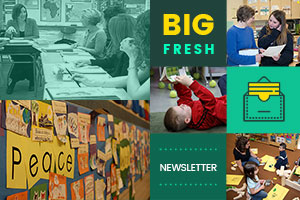Humans, not places, make memories.
Ama Ata Aidoo
On a cold winter day, I stopped at the grocery store on the way to school and bought a large tub of Swiss Miss hot chocolate mix and some styrofoam cups. I had found the old electric kettle that I used in college while cleaning out my basement and thought that some hot chocolate would be a nice surprise for my first-period class. This became our morning ritual for the rest of the month. While stirring the powdery mix into the hot water, Lydia remarked, “The is going to be one of my favorite memories of senior year.”
This got me to thinking about all the times that something funny or heartwarming happens in the classroom. Sometimes I jot these little vignettes down in my notebook, but that makes them just for me. I might look back through my notebook at the end of the school year and have a laugh or a smile while I remember these classroom memories, but it would be more fun to reminisce about them with my students.
To get the students involved in helping me collect these memorable moments, I created a class memory box–just a simple plastic index card holder with a stack of post-it notes beside it. When one of these moments pop up in class, such as the time Josh acted out an entire scene of A Midsummer Night’s Dream in a country western accent, I jot it down on a post-it and put it in the box. Students can drop a memory in the box as well, which makes the box a class effort.
Pulling the memories out at the end of the year is a lot of fun and a great way to wrap up the year on a positive note. But sometimes, when February and March drag on with no breaks in sight, a memory pulled from the box can lighten the mood and keep us going for another day. My favorite part of the memory box is that it reminds us all that as a class we have a history of shared experiences that bind us together.
This week we look at fostering more independence in learners of all ages. Plus more as always — enjoy!
Gretchen Schroeder
Contributor, Choice Literacy
Gretchen Schroeder teaches 11th and 12th grade English at Millersport High School in Ohio and is a teacher consultant for the Columbus Area Writing Project.
Free for All
[For sneak peeks at our upcoming features, quotes and extra links, follow Choice Literacy on Twitter: @ChoiceLiteracy or Facebook: http://www.facebook.com/ChoiceLiteracy or Pinterest: http://pinterest.com/choiceliteracy/]
What’s the difference between a sense of calm purpose in writing workshops and an atmosphere fraught with tension? Tara Smith finds in her sixth-grade classroom it’s the structures in place (or missing) for student independence:
http://www.choiceliteracy.com/articles-detail-view.php?id=2641
Students transition between home and school with the Community Board in Andrea Smith’s fourth-grade classroom. It’s a lively bulletin board that is updated and discussed daily:
http://www.choiceliteracy.com/articles-detail-view.php?id=2065
How can teachers help students who abandon books far more often than they stick with them? Pernille Ripp explains how she helps these “book abandoners” develop stamina for independent reading:
http://pernillesripp.com/2015/10/15/how-we-can-help-our-book-abandoners/
For Members Only
Students are always watching us, whether we realize it or not. Jennifer Schwanke explains how we can capitalize on that interest to build independent reading and writing habits:
http://www.choiceliteracy.com/articles-detail-view.php?id=2902
In this week’s video, Katherine Sokolowski models how readers make choices as questions arise while reading independently. She also demonstrates how she moves between a novel and web resources:
http://www.choiceliteracy.com/articles-detail-view.php?id=2493
Melanie Meehan uses independence bulletin boards to provide students with options when working on their own during units of study:
http://www.choiceliteracy.com/articles-detail-view.php?id=2912
Carly Ulmer develops a bingo board to use with her middle school students to give them more choice and foster independence while crafting writing in specific genres:
http://www.choiceliteracy.com/articles-detail-view.php?id=2557
In an encore video, Sean Moore demonstrates how he helps students focus their independent reading with preparation and discussion:
http://www.choiceliteracy.com/articles-detail-view.php?id=1291
That’s all for this week!



